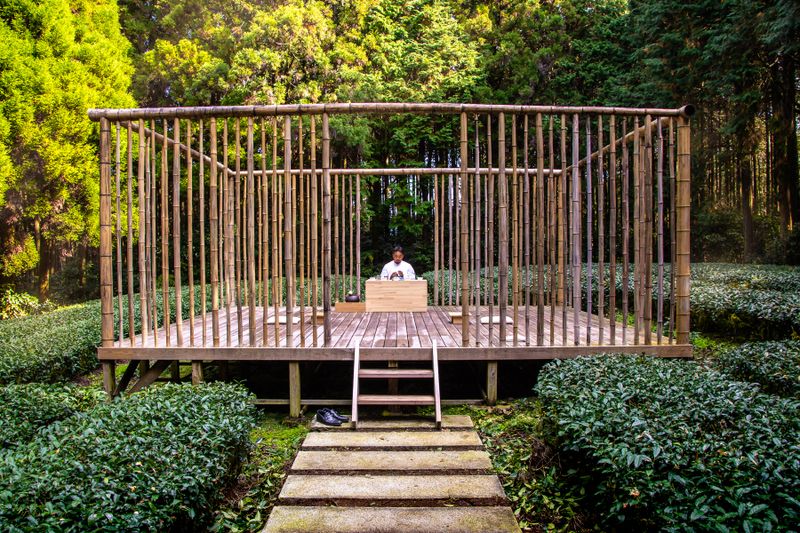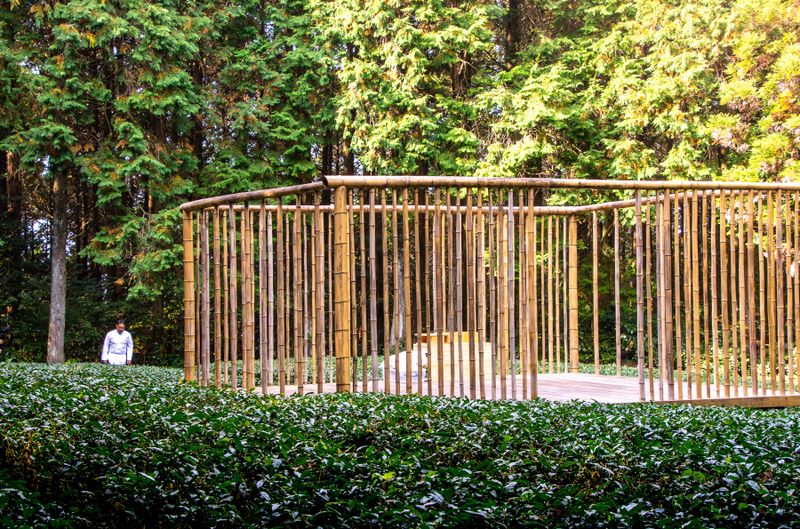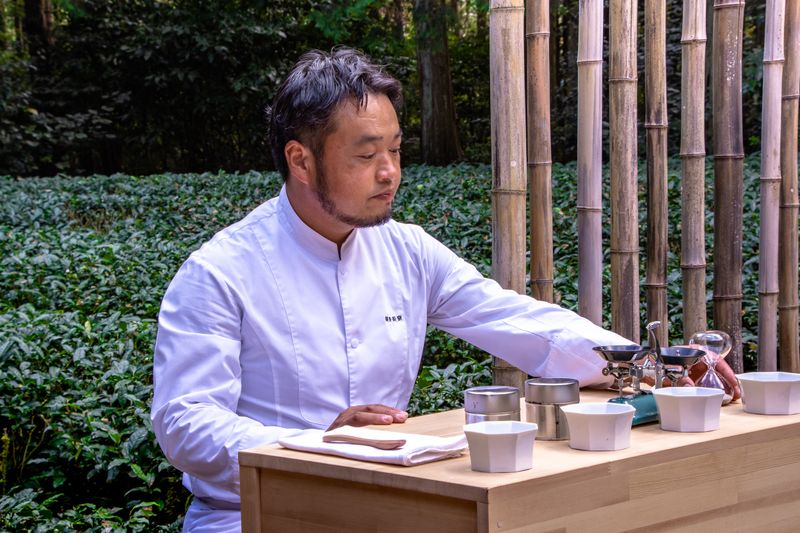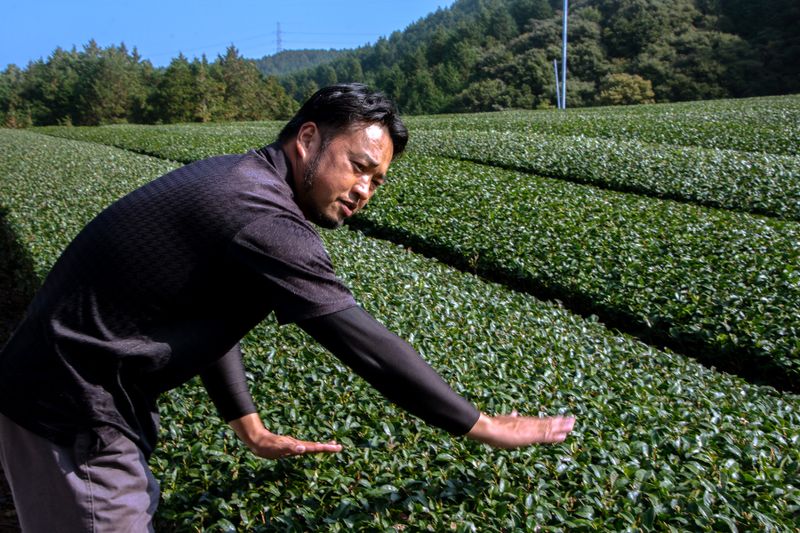Jan 25, 2022
The Ureshino Story: Farmers take Ureshino tea experience to spectacular levels
The city of Ureshino in Saga Prefecture, southwestern Japan, is home to the proud cultures of Ureshino tea, onsen (hot springs) and porcelain. This is the second article in a series telling the stories of forward-thinking, local creatives from each of these respective industries who have joined forces to help safeguard the future of Ureshino's cultures.

“Actually this isn’t the real entrance. This is a secret one.”
We’re parked up on the edges of a small mountain plateaux, decorated with the fabulous greens and immaculate symmetry of Ureshino’s tea fields.
Our host and guide, local tea farmer and “tea master” Yuya Nagao, opens a makeshift gate and leads us into the forest surrounding the plateaux. In the crisp whites of his tea master uniform Nagao cuts a striking contrast with the earthly tones of the forest all around.
It’s only a short distance to a clearing - another tea field - in the middle of which sits a charming wooden pergola, the private stage on which Nagao dispenses cups of Ureshino tea and his knowledge of the area’s cherished tea culture.
“The problem with this place is the access,” Nagao says of what is called the Mori no Chashitsu, one of a number of “tea spaces” dotted about the incredible landscape surrounding this tea-growing region in Saga Prefecture, southwestern Japan.

(Tea space Mori no Chashitsu, Ureshino, Saga Prefecture.)
Understandable. We came in via the secret entrance, but looking around it’s hard to see where the official one might be. Essentially, you’d never know this place was here, even if it does leave quite the impression, stepping out of the dark of the forest to see the tea plants and pergola lit by the brilliant autumn sun.
The hidden nature of Mori no Chashitsu could almost be symbolic of the way tea makes its appearance in Ureshino, to the casual visitor at least. At street level in the heart of the attractive onsen town, Ureshino tea - Ureshino-cha - is on display in the lobbies of luxurious ryokan, paired with designer brands, and served along with gorgeous wagashi in warmly-lit bars by experts like Nagao wearing those immaculate white uniforms.
Walking around town though, there is little sign of the tea’s origins and the kind of earthly labor that goes into its production. Discovering this contrast between farm and bar counter, though, is all part of the tea experience in Ureshino.
The drive up to Nagao’s secretive tea stage is stunning. Heading south out of town, a broad green valley makes its appearance and with it the tea plantations, those distinctive rows clinging to the steep mountain slopes on either side. Narrow lanes snake their way up from the valley floor, through small villages - one of which Nagao calls home - and into the lofty heights of the plantations. The hairpin turns are sometimes so tight that in larger vans like ours they need to be navigated in awkward stages.
The drive up into the mountains, the tingling sense of secrecy and discovery, the performance of Nagao’s uniform and his perfect pouring technique and, of course, the tea. Not just a beverage in these parts, but a glorious experience.
Tea is nothing new in Ureshino, the culture has been here for over 500 years - one of the area’s triumvirate of traditions, along with onsen and the local Hizen Yoshida-yaki porcelain. In recent years though, farmers like Nagao have been taking on new approaches and ideas to grow the tea experience.
In 2016 Nagao joined other figures from the local industries of tea, onsen and porcelain who had come together to form what would eventually become known as Ureshino Chadoki, a creative association taking on the challenge of safeguarding the future of Ureshino’s celebrated traditions, and perhaps with them the future of the town.
Early Ureshino Chadoki events saw Nagao and fellow tea masters brewing and serving their teas directly to customers, in events that also brought local foods and local Hizen Yoshida-yaki tableware to the party.
The success of these early events and the exchange of ideas with other Ureshino Chadoki members gave Nagao a new perspective on the value of his tea.
“After becoming part of Chadoki my thinking around branding and raising awareness of Ureshino tea changed. When the customer drinks the tea directly in front of you and you see their reaction, it enables you to re-evaluate the value of the tea,” Nagao said.
Greater value when at the heart of a greater experience, perhaps.
“Some people say that the culture of tea has become obsolete. That tea is just something you drink at home after dinner, or something that you get in a plastic bottle. The culture of drinking tea in other countries, where you enjoy taking your time over the brewing and drinking, is maybe something which hasn’t much traction in Japan these days.”
It could be gaining traction though, up here in the mountains around Ureshino.
When not working the earth of his farm, Nagao told us of how busy he has been guiding and serving Ureshino-cha to visitors from outside of Saga, at the town’s spectacular tea spaces like Mori no Chashitsu, the kind of place that demands one takes time to savor the experience.
It’s the kind of work that requires Nagao to be in his tea master whites.


(Tea master Yuya Nagao prepares to serve tea at Mori no Chashitsu, Ureshino, Saga Prefecture.)
Back in town Nagao answered our questions in the lobby of the spectacular ryokan Wataya Besso in the center of Ureshino, the town, before taking us out to the mountains.
Around the corner from the lobby, at the hotel bar, some of Nagao’s peers were serving up the tea experience in their crisp white uniforms. Behind Nagao sat a display of tea products - a collaboration between Wataya Besso and the brand of French pastry chef and chocolatier Pierre Hermé.
Despite the glamorous setting, before us sat Nagao the farmer, quiet and gently spoken and in his functional farmwear cutting a similar contrast to the luxury hotel surroundings as he would wearing his tea master whites in the mountain forest.
“Of course, I don't wear the white clothes to work in the field. The exact opposite in fact,” he explained.
“I mean, it's fine to take on the appearance of a farmer and take people out to the fields and just have them sit on some kind of container and serve them tea, but creating a special space and adding a kind of performance element to it, adds to the value of the tea.”
“I think that drinking the same tea in a beautiful space compared to doing so while sitting on a simple container will lead to the feeling of a different taste in the tea. I think this is really important,” he said.
The tea master uniforms go back to the first of the Ureshino Chadoki events where the original idea had been to don something darker, a little more like a coffee barista, until the suggestion of “divine white” was made.
“It was the first time for me to be dressed all in white and at first it didn't really fit. It didn't feel right. Now it's the perfect fit,” Nagao said.
Getting to grips with the presentation element of being a tea master is not only vital in serving-up the Ureshino tea experience to paying customers, it also reflects an even greater responsibility facing local tea farmers like Nagao.
“The point of Ureshino Chadoki was to preserve the three major industries of Ureshino. But if it's only us who remain involved with Chadoki, we'll get older and eventually it will end.”
“Also, my village is depopulating. Right now, our's really is the only household in the village with children,” Nagao said of his tea-farm home (and that of his parents and their grandchildren) in the mountains surrounding Ureshino.
“Maybe 30 years from now, no one will be home.”
Nagao’s somber observation highlights the pressing need for successors to pick up Ureshino’s traditions and industries.
“If you order people to do it, try and pull them along, it's not going to work. They actually have to want to do it,” Nagao explained of the tricky business of ensuring a successor for his own farm - a challenge similar to that facing the Ureshino Chadoki group.
“I have a son and, for me, I'd like him to take over the farm after me. In this respect, the only thing people like me can do is to show others that we are glad to have chosen our particular path.”
Whatever the importance of the presentation though, the Ureshino tea experience, like any other experience, can only offer real value through authenticity. Talking to Nagao, seeing him in the mountains and tea fields, you feel an authenticity that shines brighter even than the divine whites of the Ureshino tea master get-up.

(Tea farmer Yuya Nagao, Ureshino, Saga Prefecture.)
“Actually, for us, I think we’d prefer to be referred to as “tea farmers” but we also hold the license of “tea master” which fits what we do when we serve tea in the tea spaces,” he said.
Nearing the end of our interview we asked Nagao where his favorite place to drink tea was.
“You'll see later that my parents' house is right in the mountains, surrounded by beautiful scenery. For me, I think this is the best place to drink tea, out in the mountains,” he said.
“I want to have people come to the area so that I can show them that such a place exists.”
This article was supported by Ureshino Chadoki.



0 Comments